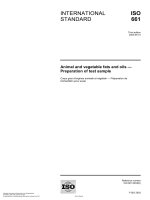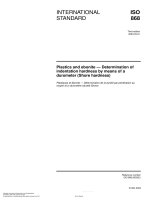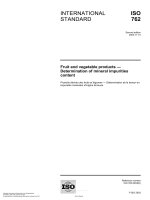Tiêu chuẩn iso 16586 2003
Bạn đang xem bản rút gọn của tài liệu. Xem và tải ngay bản đầy đủ của tài liệu tại đây (165.24 KB, 12 trang )
INTERNATIONAL
STANDARD
ISO
16586
First edition
2003-04-01
Soil quality — Determination of soil water
content as a volume fraction on the basis
of known dry bulk density — Gravimetric
method
--`,,`,-`-`,,`,,`,`,,`---
Qualité du sol — Détermination de la teneur en eau volumique du sol à
partir de la masse volumique apparente sèche connue — Méthode
gravimétrique
Reference number
ISO 16586:2003(E)
Copyright International Organization for Standardization
Provided by IHS under license with ISO
No reproduction or networking permitted without license from IHS
© ISO 2003
Not for Resale
ISO 16586:2003(E)
PDF disclaimer
This PDF file may contain embedded typefaces. In accordance with Adobe's licensing policy, this file may be printed or viewed but
shall not be edited unless the typefaces which are embedded are licensed to and installed on the computer performing the editing. In
downloading this file, parties accept therein the responsibility of not infringing Adobe's licensing policy. The ISO Central Secretariat
accepts no liability in this area.
Adobe is a trademark of Adobe Systems Incorporated.
--`,,`,-`-`,,`,,`,`,,`---
Details of the software products used to create this PDF file can be found in the General Info relative to the file; the PDF-creation
parameters were optimized for printing. Every care has been taken to ensure that the file is suitable for use by ISO member bodies. In
the unlikely event that a problem relating to it is found, please inform the Central Secretariat at the address given below.
© ISO 2003
All rights reserved. Unless otherwise specified, no part of this publication may be reproduced or utilized in any form or by any means,
electronic or mechanical, including photocopying and microfilm, without permission in writing from either ISO at the address below or
ISO's member body in the country of the requester.
ISO copyright office
Case postale 56 • CH-1211 Geneva 20
Tel. + 41 22 749 01 11
Fax + 41 22 749 09 47
Web www.iso.org
Published in Switzerland
ii
Copyright International Organization for Standardization
Provided by IHS under license with ISO
No reproduction or networking permitted without license from IHS
© ISO 2003 — All rights reserved
Not for Resale
ISO 16586:2003(E)
Foreword
ISO (the International Organization for Standardization) is a worldwide federation of national standards bodies
(ISO member bodies). The work of preparing International Standards is normally carried out through ISO
technical committees. Each member body interested in a subject for which a technical committee has been
established has the right to be represented on that committee. International organizations, governmental and
non-governmental, in liaison with ISO, also take part in the work. ISO collaborates closely with the
International Electrotechnical Commission (IEC) on all matters of electrotechnical standardization.
--`,,`,-`-`,,`,,`,`,,`---
International Standards are drafted in accordance with the rules given in the ISO/IEC Directives, Part 2.
The main task of technical committees is to prepare International Standards. Draft International Standards
adopted by the technical committees are circulated to the member bodies for voting. Publication as an
International Standard requires approval by at least 75 % of the member bodies casting a vote.
Attention is drawn to the possibility that some of the elements of this document may be the subject of patent
rights. ISO shall not be held responsible for identifying any or all such patent rights.
ISO 16586 was prepared by Technical Committee ISO/TC 190, Soil quality, Subcommittee SC 5, Physical
methods.
iii
© ISO 2003 — All rights reserved
Copyright International Organization for Standardization
Provided by IHS under license with ISO
No reproduction or networking permitted without license from IHS
Not for Resale
ISO 16586:2003(E)
Introduction
--`,,`,-`-`,,`,,`,`,,`---
The determination of water content volume fraction using coring sleeves, which is described in ISO 11461, is
the basic method for determination of the water content volume fraction. This International Standard provides
a less precise method than that given in ISO 11461.
iv
Copyright International Organization for Standardization
Provided by IHS under license with ISO
No reproduction or networking permitted without license from IHS
© ISO 2003 — All rights reserved
Not for Resale
INTERNATIONAL STANDARD
ISO 16586:2003(E)
Soil quality — Determination of soil water content as a volume
fraction on the basis of known dry bulk density — Gravimetric
method
1
Scope
This International Standard specifies a method for the gravimetric determination of soil water content as a
volume fraction on the basis of the ratio of measured water content mass to known dry bulk density.
This International Standard is applicable to all types of non-swelling or non-shrinking soils. It is used as a
reference method (e.g. the calibration of indirect methods for determination of water content).
2
Normative references
The following referenced documents are indispensable for the application of this document. For dated
references, only the edition cited applies. For undated references, the latest edition of the referenced
document (including any amendments) applies.
ISO 11465:1993, Soil quality — Determination of dry matter and water content on a mass basis — Gravimetric
method
3
Terms and definitions
3.1
water content
water content mass fraction
water content mass ratio
ratio of the mass of water evaporating from the soil when dried to constant mass at 105 °C, to the dry mass of
the soil sample
NOTE
For soil with high content of organic matter, drying at a temperature below 70 °C is usual practice.
3.2
dry bulk density
mass of the solid particles divided by the undisturbed bulk volume of the soil
3.3
water content volume fraction
volumetric water content
ratio of the volume of water evaporating from the soil when dried to constant mass at 105 °C, to the original
bulk volume of the soil
1
--`,,`,-`-`,,`,,`,`,,`---
© ISO 2003 — All rights reserved
Copyright International Organization for Standardization
Provided by IHS under license with ISO
No reproduction or networking permitted without license from IHS
Not for Resale
ISO 16586:2003(E)
4
Symbols
sx
sample standard deviation of variation of variable x;
w
water content (mass fraction), expressed in kilograms per kilogram;
∆x
standard deviation of the errors in variable x;
ϕ
water content volume fraction, expressed in cubic metres per cubic metre;
ρ b dry bulk density, expressed in kilograms per cubic metre;
ρw density of water, expressed in kilograms per cubic metre.
5
Principle
Soil samples are dried to constant mass at 105 °C. The difference in the mass of the soil sample, before and
after the drying procedure, is taken as a measure of the water content. The water content (mass fraction) is
converted to the water content (volume fraction) by using a known value for the dry bulk density. This method
is inherently less accurate than ISO 11461, since the dry bulk density is not determined on the same sample.
NOTE
The dry bulk density may be known from previous sampling. If the dry bulk density is not known, it can be
determined in accordance with ISO 11272.
6
Apparatus
Equipment for determination of water content as a mass fraction shall be in accordance with ISO 11465.
Procedure
Sampling, transport and laboratory treatment of the samples shall be carried out in accordance with
ISO 11465.
NOTE
Usually larger samples are needed than those specified in ISO 11465. For structured soils, a sample including
20 structural elements is satisfactory for most investigations.
8
Expression of results
Calculate w in accordance with ISO 11465. Compute the water content volume fraction from:
ϕ=w
ρb
ρw
where
w
is the water content mass fraction;
ϕ
is the water content volume fraction;
ρ b is the dry bulk density of the sample, in kilograms per cubic metre;
2
Copyright International Organization for Standardization
Provided by IHS under license with ISO
No reproduction or networking permitted without license from IHS
© ISO 2003 — All rights reserved
Not for Resale
--`,,`,-`-`,,`,,`,`,,`---
7
ISO 16586:2003(E)
ρw is the density of water at soil temperature, in kilograms per cubic metre (usually an approximation of
1 000 kg m−3 will be satisfactory for this method)
NOTE
The water content (mass fraction) in accordance with ISO 11465 is expressed as a percentage. This number
can be converted to a decimal fraction by dividing by 100.
9
Accuracy and precision
9.1 Various error sources influence the accuracy of the calculated water content through errors in w, ρ b and
ρw. The basic inaccuracies due to sampling, transport and laboratory handling have to be assessed within the
procedures given in ISO 11465 (w) and ISO 11272 (ρ b), as well as the final error in these variables. For
convenience, a summary of the assessment of these errors is given in Annex A.
9.2 Temperature differences between the field and laboratory introduce a deviation in ρw. If this systematic
error occurs, a correction shall be established for it. The uncertainty in this correction shall then be applied as
the final systematic error, hence: corr. ∆ρw.
9.3 After estimation of the standard deviation of the respective error sources in w, ρ b and ρw, their
propagation in the water content can be estimated with the following formula:
2
2
2
ρ
w 2
ϕ 2
s ϕ = b s w2 +
s ρb +
sρw
ρw
ρw
ρw
where sϕ, sw, sρ b and sρ w are the standard deviations of ϕ, w, ρ b and ρw respectively.
In the final result one may distinguish between the (total) variable component in time and space sϕ(t,x) and the
(total) systematic component sϕ (see Annex A).
General guidelines for the actual magnitude of specific error sources cannot be given, since they fully depend
on sampling and laboratory practice. Apart from the error sources in ρ b as elaborated in Annex A, the
temporal and spatial variabilities in this variable shall be taken into account, due to differences in both
sampling sites and sampling times between w and ρ b.
10 Test report
The test report shall include following information:
a)
reference to this International Standard;
b)
an accurate description of the sampling location and depth;
c)
the date of field sampling;
d)
the mass of the soil sample used for the determination;
e)
the dry bulk density value(s) used, the method used to determine the dry bulk density, the time and sites
used for the dry bulk density determination(s);
f)
the calculated water content (volume fraction);
g)
details of any operations not specified in this International Standard, or regarded as optional, as well as
any other factors which may have affected the results.
--`,,`,-`-`,,`,,`,`,,`---
3
© ISO 2003 — All rights reserved
Copyright International Organization for Standardization
Provided by IHS under license with ISO
No reproduction or networking permitted without license from IHS
Not for Resale
ISO 16586:2003(E)
Annex A
(informative)
The accuracy of w and ρb
A.1 General
At present ISO 11465 and ISO 11272 do not provide for procedures for estimation of the errors in w and ρ b. In
this Annex these errors are elaborated.
A.2 Symbols
The following new symbols are used in this Annex:
m1 mass of the field-moist soil sample, in kilograms;
m2 mass of the dried soil sample, in kilograms;
sx
sample standard deviation of variation of variable x;
V
volume of the soil sample, in cubic metres;
∆x standard deviation of the errors in variable x.
A.3 Basic sources of w error
In the course of the procedures followed for determination of
that can influence the calculated values.
a)
w, the following main causes of error are present
Storage
Evaporation of water from moist soil samples or sorption of water from the air by relatively dry samples
can occur due to poor closure of the transport bags and/or a too long period for transport or storage. The
susceptibility of the sample to such changes in water content is influenced by its initial water content. If
this systematic error occurs, a correction should be established for it. The uncertainty in this correction
should then be applied as the final systematic error, hence: corr. ± ∆m .
1
b)
Laboratory analysis
1)
poor precision of the weighing balance, which results in a variable error in weighings in both time and
space (t, x), hence:∆m (t,x) and ∆m (t,x);
1
2)
2
poor precision of the weighing balance, which results in a variable error in the weighing of the
moisture box used for drying the soil. This error influences the calculation of m2, hence: ∆m (t,x)
2
3)
volatilization of substances other than water. Also in this case one should establish a correction for
this effect, hence: corr. ± ∆m
1
--`,,`,-`-`,,`,,`,`,,`---
4
Copyright International Organization for Standardization
Provided by IHS under license with ISO
No reproduction or networking permitted without license from IHS
© ISO 2003 — All rights reserved
Not for Resale
ISO 16586:2003(E)
4)
sorption of moist air due to a too long time gap between removing the sample from the desiccator
and the second weighing. This also calls for a correction: corr. ± ∆m .
2
5)
variations in the time and temperature of drying.
A.4 Propagation of errors in w
After estimation of the standard deviation of all of the respective error sources in m1 and m2, their propagation
in w can be estimated with the following formula:
2
sw
m 2
1 2
1
=
s m1 + 2 s m 2
m
2
m2
where
sm and sm
1
2
are the standard deviations of the errors influencing m1 and m2 respectively;
sw
is the standard deviation of the determination of w.
The formula results in total errors irrespective of their behaviour in time and/or space. One may distinguish
between the (total) variable component ∆(t,x) and the (total) systematic component ∆, according to A.3 b) 1) to
A.3 b) 5).
A.5 Basic sources of ρ b error
In the course of the procedures followed for determination of ρ b, the following main causes are present that
can influence the calculated values:
a)
Sampling
1)
Compaction and/or disturbance of the sample.
Various factors, including the compressibility of the soil, the presence of stones and the sharpness of
the cutting edge influence whether a sample is disturbed and/or compacted to some extent during
sampling. These factors may cause variable and/or systematic errors in time and space. The variable
(i.e. coincidental) error component occurs in time and space (t,x) with respect to m2: ∆m (t,x).
2
Systematic errors may occur and if possible, a correction should be established for these. The
uncertainty in this correction should then be applied as the final systematic error, hence: corr. ± ∆m .
2
b)
2)
Deviation in the sample volume due to imperfect cutting of the sample. This results in a variable error
of the type ∆V(t,x);
3)
Poor precision of the volume of the sample sleeve. One should establish a correction for this effect,
hence: corr. ± ∆V;
Laboratory analysis
1)
Poor precision of the weighing balance, which results in a variable error, hence: ∆m (t,x).
2)
Volatilization of substances other than water. Also in this case one should establish a correction for
this effect, hence: corr. ± ∆m .
2
2
--`,,`,-`-`,,`,,`,`,,`---
5
© ISOfor2003
— All rights reserved
Copyright International Organization
Standardization
Provided by IHS under license with ISO
No reproduction or networking permitted without license from IHS
Not for Resale
ISO 16586:2003(E)
3)
Sorption of moist air due to a too long time gap between removing the sample from the desiccator
and the second weighing. This too calls for a correction: corr. ± ∆m .
2
A.6 Propagation of errors in ρ b
After estimation of the standard deviation of the respective error sources in m2 and V, their propagation in ρb
can be estimated with the following formula:
2
2
m
1 2
+ 2 s V2
s ρ = sm
b
2
V
V 2
where sm and sV are the standard deviations of the errors influencing m2 and V respectively and the standard
2
deviation of the determination of ρ b.
--`,,`,-`-`,,`,,`,`,,`---
The formula results in total errors irrespective of their behaviour in time and/or space. One may distinguish
between the (total) variable component ∆(t,x) and the (total) systematic component ∆, according to A.5 a) and
A.5.b).
6
Copyright International Organization for Standardization
Provided by IHS under license with ISO
No reproduction or networking permitted without license from IHS
© ISO 2003 — All rights reserved
Not for Resale
ISO 16586:2003(E)
Bibliography
ISO 11461:2001, Soil quality — Determination of soil water content as a volume fraction using coring
sleeves — Gravimetric method
[2]
ISO 11272:1998, Soil quality — Determination of dry bulk density
--`,,`,-`-`,,`,,`,`,,`---
[1]
7
© ISO 2003 — All rights reserved
Copyright International Organization for Standardization
Provided by IHS under license with ISO
No reproduction or networking permitted without license from IHS
Not for Resale
--`,,`,-`-`,,`,,`,`,,`---
ISO 16586:2003(E)
ICS 13.080.40
Price based on 7 pages
© ISO 2003 — All rights reserved
Copyright International Organization for Standardization
Provided by IHS under license with ISO
No reproduction or networking permitted without license from IHS
Not for Resale









